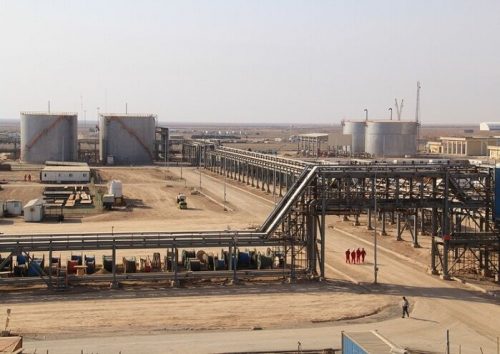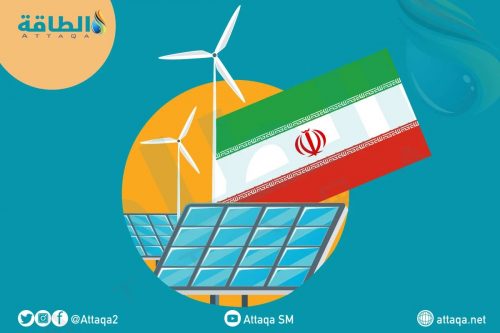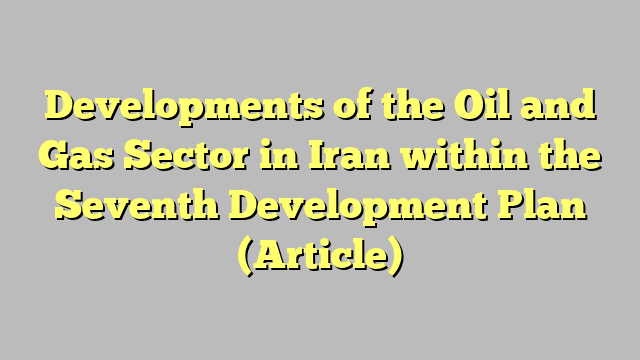Read in this article
- • The plan aims primarily to address the biggest economic problems facing the country
- • The Sixth Development Plan faced major challenges in the petroleum industry
- • The policies of the Seventh Development Plan do not provide a clear pattern of development and transformation in the oil and energy sector
- • An investment of $250 billion is needed to increase oil, gas and petrochemical production
- • The continuation of the current foreign policy may exacerbate the problems related to the energy crisis
Last week, Iran announced the final document of the seventh five-year plan for the country’s economic, social and cultural development. Government officials, including First Vice President Mohammad Mokhber and Head of the Planning and Budgeting Organization (PBO) Daoud Manzour, attended the meeting to announce the plan, as well as representatives from the private sector in the country.
Manzoor stressed during the ceremony that the seventh plan aims to solve problems, with the aim of addressing economic imbalances such as the lack of balance in the budget, energy and the banking system, and strengthening the authority of the central bank.
The Iranian official claims that the strategy takes into account people’s health and livelihood.
The Iranian First Vice President, Mohammad Mokhber, stated that the government committees in charge considered and analyzed the draft law of the Seventh Development Plan.
“We hope that what was prepared and unveiled today will meet the needs of the country in the next 5 years,” he added.
The plan, which the official referred to, consists of 22 chapters and sections, primarily aimed at addressing the biggest economic problems facing the country.
The energy sector and the Sixth Development Plan

Despite its comprehensive strategies and indicators, the Sixth Development Plan in Iran faced great challenges in the petroleum industry sector, and failed to achieve its desired goals. The main obstacle facing the plan was the impact of the sanctions imposed in Iran.
The plan estimated the need for $35 billion in domestic and international investments to achieve an annual growth in GDP of 2.8%.
In addition, it was necessary to invest $175 billion over 5 years to achieve a growth rate of 8%.
And given the reluctance of global investors to deal with Iran in light of the US sanctions, achieving these goals has become almost impossible. The plan provided for great achievements, especially in the fields west of Karun, with a targeted daily oil production of approximately 4.5 million barrels.
The plan aimed to increase the production of gas condensate in proportion to gas production, to reach 864 thousand barrels per day, and to enable the generation of 1.3 billion cubic meters per day.
The Sixth Development Plan, which was originally scheduled to cover the period 2017-2021, faced obstacles that led to its extension. The Islamic Consultative Council extended the plan for a maximum period of 6 months, while allowing it to continue until the adoption of the Seventh Development Plan Law.
This plan coincided with the Joint Comprehensive Plan of Action, and the withdrawal of the United States from the Joint Comprehensive Plan of Action increased the complexity of its implementation and created great challenges for its success.
Seventh development plan
In Iran’s seventh national development plan, issues related to oil and energy were limited to the following points:
– Clarifying and organizing the revenues and expenses of the National Oil Company and other government companies in the budget, and the careful and comprehensive implementation of this one point can lead to a major transformation in the country’s economy and executive system.
Infrastructure
– Increasing the ceiling of crude oil and natural gas production in the joint fields, increasing the extraction factor in the independent fields, and increasing the added value by completing the oil and gas value chain.

– The implementation of many national mega-economic projects that are oriented towards infrastructure, sustainable and future, and although this point has a general aspect, the oil industry has a superior ability to implement huge projects with high added value, as mentioned in this point.
– Activating geopolitical advantages and transforming the Islamic Republic of Iran into a center for energy services, trade, communications and transportation, by regulating regulations and developing the necessary infrastructure.
At this point, the use of Iran’s geographical location to become an energy hub was mentioned. Achieving this important goal requires the creation of infrastructure and reform of regulations to make Iran internationally competitive, which must be achieved through professional economic diplomacy.
– Promote the economy-centred approach in foreign policy, regional and international relations, and promote economic relations with neighbors as a priority.
The oil industry has an international character, both in terms of attracting foreign investment, technical knowledge, financing, entering global markets to sell products, and even insurance coverage for international companies in the field of foreign policy.
The Seventh Development Plan, according to Paragraph 22, by emphasizing the economic centralization of foreign policy and considering the country’s “tangible and economic interests” in international forums, can enhance energy diplomacy and pave the way for increasing the share of the Iranian oil industry in international markets.
This will allow the entry of capital and modern technical know-how, and the extraction of valuable oil and gas resources in the best possible way. Crude oil sales can be reduced by developing petrochemical industries.
The plan provides for an annual deposit of 30% of the resources derived from oil and gas exports and net gas exports in the National Development Fund, and to increase it by at least two percentage points annually.
The plan provides for encouraging the participation of non-governmental and private companies to invest in exploration activities and associated gas collection, containment, monitoring and utilization projects.
Interest in renewable and clean energy
The policies of the Seventh Development Plan stipulate an interest in reducing energy intensity and improving its consumption patterns, without the plan’s policies providing a clear pattern for development and transformation in the oil and energy sector.
Therefore, state policies on development plans must follow a rational and capacity-based objective and follow a rational path for at least 20 years, in order to be effective.
Regular laws and annual budgets must be within the framework of action, and must be consistent with the five-year development plans, and these plans must be in line with the general policies that govern each program.
The Seventh Development Plan stresses the importance of production-sharing contracts in common fields, such as South Pars, the Caspian Sea and West Karun, but their implementation depends on lifting sanctions.
On the other hand, defects in the gas storage and transmission network pose challenges. The electricity industry requires 5,000 megawatts of new power stations annually, with investments of $5 billion, compensating the deficit, and stopping the old stations.
Oil and gas in Iran
In addition, an investment of $250 billion is needed to increase oil, gas and petrochemical production, although securing financial resources is a challenge.
Dependence on foreign exchange income from energy exports is unlikely to finance Iran’s energy infrastructure.
Competition in the global energy market, maintaining market share, and ensuring energy security are challenges.
The limited success in signing operational contracts with foreign companies, with the exception of Chinese companies, is evident, and the lack of coordination between the Seventh and Sixth Development Plans requires a long-term roadmap and consistent decisions to achieve effective results.
Implementing the energy industry targets of the Seventh Development Plan without reviving the JCPOA is a challenge.
The revitalization of the Joint Comprehensive Plan of Action and approval of the Financial Action Task Force are critical to addressing energy issues and improving international relations.
The continuation of the current foreign policy may exacerbate the problems related to the energy crisis.
Fundamental changes in policies, development priorities and the economy are essential to achieving the goals of the energy industry and implementing the plan, and cooperation in the energy sector with other countries is critical.
* Dr. Omod Shoukry, senior advisor on foreign policy and energy geopolitics, is the author of “US Energy Diplomacy in the Caspian Basin: Changing Trends Since 2001.”
*This article represents the opinion of the author, and does not necessarily reflect the opinion of the energy platform.
related topics..
Also read..

Leave a Reply